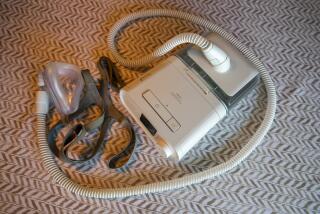Doctors Object to Monitor for Early Labor
- Share via
A home-monitoring device for pregnant women subject to early deliveries fails to prevent premature births, costs too much and should never have been approved for routine use, a group of prominent obstetricians contended in a letter published in today’s New England Journal of Medicine.
In the letter, the physicians criticized the U.S. Food and Drug Administration for approving the device, manufactured by Santa Ana-based Tokos Medical Corp., in September, 1990, without proof that it actually lowers the risk of premature deliveries.
The device, called the Genesis home uterine activity monitor, is to detect pre-term labor so it can be stopped. Since FDA approval, it has been used by more than 75,000 women, according to Tokos.
“A lot of people feel this device is unproven, and we need as physicians to monitor the technology we’re using,” said Dr. Benjamin P. Sachs, chief of obstetrics and gynecology at Beth Israel Hospital in Boston and principal author of the article. Most of the signers are prominent in the American College of Obstetrics and Gynecology.
After reports of the journal letter, Tokos stock fell $1.25 Wednesday, closing at $34.75 in over-the-counter trading.
The bulk of Tokos business is in leasing the monitoring device to physicians, said John Hindelong, an analyst with Donaldson, Lufkin & Jenrette Securities in New York. The company, which provides home health-care equipment and services, reported revenue of $82.3 million for the first nine months of this year and attributes most of a 40% revenue increase in the past year to business generated by the monitoring device.
Sachs said during an interview that the expense of the device--$5,000 per pregnancy--diverts resources away from the more important issue of universal access to prenatal care. Also, there is no sure way to screen for risk of premature labor, Sachs said, and the treatment available for arresting early labor can injure the mother.
In an interview, Craig Davenport, president of Tokos, responded that the device was never intended to prevent pre-term labor, only to alert physicians to any danger. Sachs’ cost argument is flawed, he said, because the expense of treating a prematurely born child is $30,000 on average and can reach $1 million. He agreed that methods for selecting women most at risk of premature delivery are imperfect.
Candace Hurley, 37, a Laguna Beach resident, used the device--which transmits data to Tokos’ central office--while pregnant with both of her sons, who were born 12 months apart.
“Because I had the home monitor (during the second pregnancy), I was able to stay home with my baby,” said Hurley, who is involved in organizing a national support group for women who give birth prematurely and their families. “It’s like having a nurse at your side all the time.
Pre-term birth is the leading contributor to the U.S. infant mortality rate, which is higher than the rates in 22 other industrialized nations, officials say.
The Associated Press contributed to this story.





